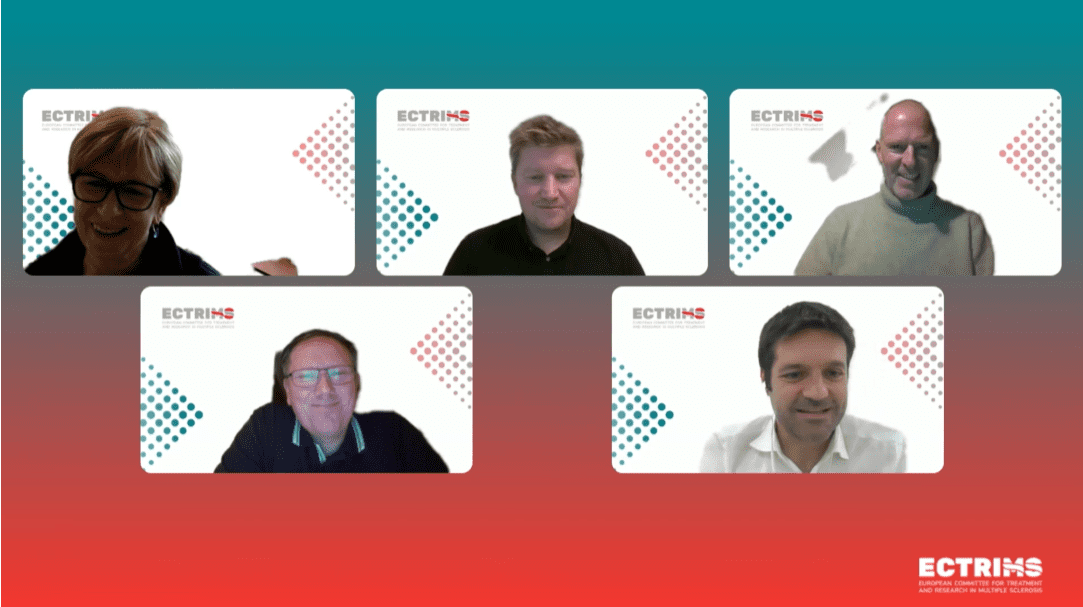
This webinar focuses on the synergetic effects of Disease-Modifying Therapies (DMTs) and rehabilitation in Multiple Sclerosis (MS). Professor Lars Hvid from the Danish MS (Rehabilitation) Hospitals and RIMS moderates the discussion.
Together, DMTs and Rehabilitation can help slow disease progression, strengthen neurological reserve, and improve quality of life. DMTs target inflammation and relapse prevention, while rehabilitation strengthens and preserves brain and body function — two complementary paths toward long-term brain health.
Professor Emilio Portaccio from the University of Florence discusses the efficacy and effectiveness of DMTs in modifying the overall course of MS and reducing relapses and disability as measured on the EDSS (Expanded Disability Status Scale). However, their impact on other symptoms, such as cognitive impairment, appears to be less pronounced.
Professor Ploughman from the Memorial University of Newfoundland (Canada) explains that, even when the brain appears structurally almost normal on conventional imaging, there may be a functional disintegration of connectivity networks. This subtle disruption represents an important aspect of disability that can evolve beneath the surface.
“It is important to prevent the onset of progression with early treatment”, Prof Portaccio adds.
Professor Peter Feys from UHasselt agrees that structural imaging alone is not sufficient to fully capture the pathological processes occurring in the brain. Functional MRI studies show that cortical tasks—those that predominantly activate higher cortical regions—often require greater oxygen use in people with MS than in healthy controls. This increased activation reflects the brain’s attempt to compensate functionally while structural damage may still appear limited. It highlights the need to pay close attention to functional connectivity, activation patterns, and the volume of activation required to maintain apparently normal performance.
Professor Ulrik Dalgas from Aarhus University notes that outcomes such as walking ability, fatigue, and cognition often show limited or no improvement following DMT treatment. This represents an important limitation of current DMTs — and highlights the need to address these areas more effectively through rehabilitation.
Prof Portaccio adds that the pathological mechanisms targeted by today’s DMTs may not fully overlap with those underlying symptoms such as fatigue and complex motor dysfunction. Smouldering inflammation may drive the silent and progressive accumulation of disability. Cognitive impairment and fatigue are typical manifestations of this ongoing process. With the development of new therapies, there is hope that we will be able to better control microglial activation and its contribution to disease progression.
In animal models, combining medication with physical exercise appears to have an additive effect on remyelination in MS — a concept researchers have aptly called “MedXercise.” (see for instance Lozinski, Brian M., and V. Wee Yong. “Exercise and the brain in multiple sclerosis.” Mult. Scler. J. 28.8 (2022): 1167-1172.) Professor Ploughman highlights the different aspects of rehabilitation. These include symptom management—such as improving sleep and posture to alleviate symptoms; lifestyle management, which addresses exercise, diet, fatigue, and daily routines; and task-oriented training, which focuses on re-learning lost abilities or learning to perform tasks in new ways. This type of intensive, focused therapy typically requires eight weeks or more and relies on neuroplasticity. When therapy concludes, the goal is to ensure that the newly acquired abilities are retained and integrated into daily life.
Watch the webinar replay here: https://my.ectrims.eu/programme/session/69088